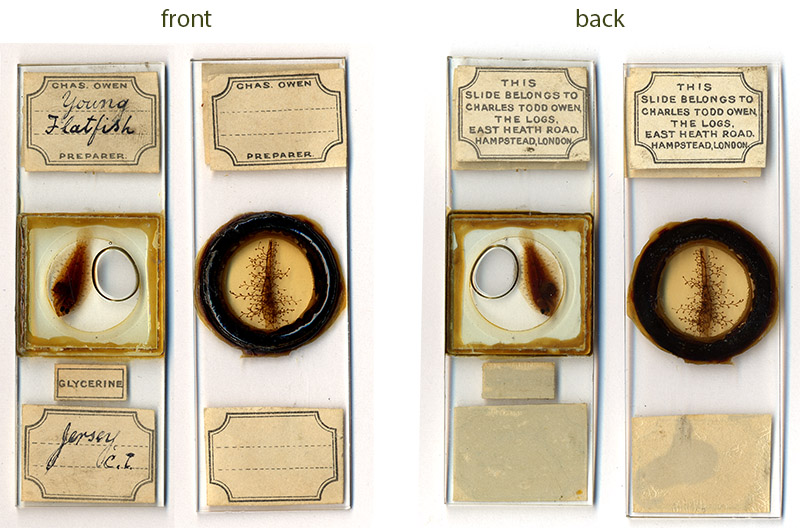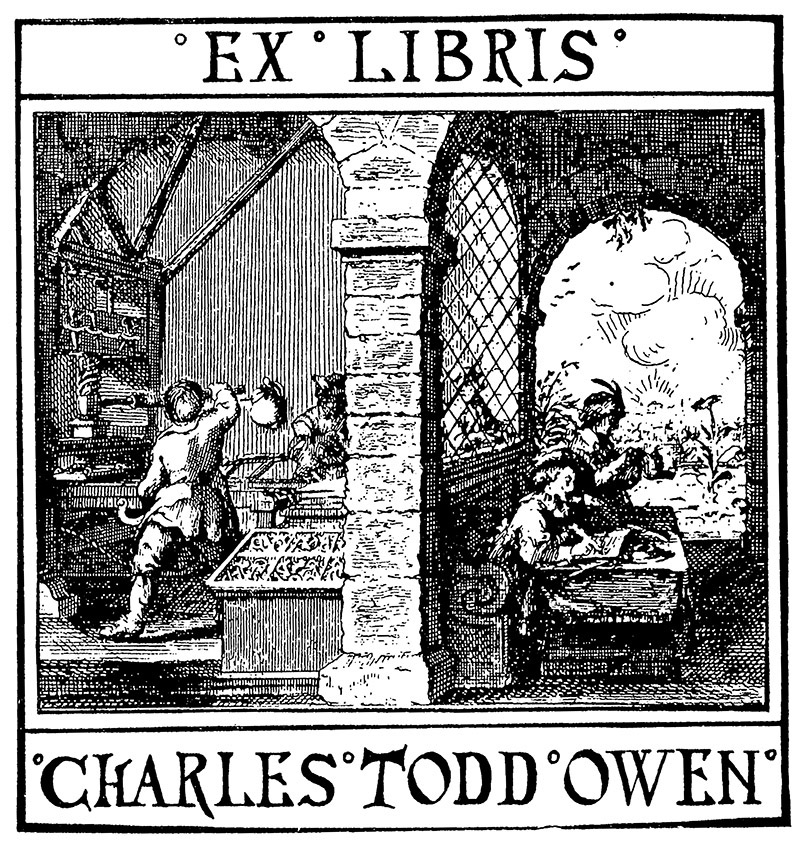Charles Todd Owen, 1870 - 1941
by Brian Stevenson
Last updated February 2015
Charles Owen’s microscope slides are
generally of very good quality, although they are not frequently encountered. They
are particularly notable for the labels’ resemblance to those used by Frederic
Enock, Clarke & Page, and several other early 1900s
microscopists, although there are no known connections between Owen and any of
those other men.
Owen was an amateur microscopist
and, if the labels on known slides are indicative of the time of production, he
picked up the hobby rather late in life. The two slides illustrated in Figure 1
include labels on the backs with Owen’s address of “The Logs, East Heath Road, Hampstead, London”, which was his
address from no earlier than 1921 until around the time of his death.

Figure 1.
Two microscope slides labeled as
having been prepared by Charles Todd Owen. On the back of each is an addition
label with his address: “The Logs, East Heath Road, Hampstead, London”. That
address dates these slides to between ca. 1921 and 1941.
Charles Todd Owen was born during
early 1870, in Bath, Somerset, England. He was the first child of Thomas and
Elizabeth Owen, and named after his maternal grandfather, Charles Todd. A
draper at the time of his son’s birth, Thomas purchased a paper mill in Cardiff
in 1877, forming a partnership with Samuel Evans. After Evans died in 1885, the
company became Thomas Owen and Company. He also acquired partnerships in
several newspapers. Thomas was elected to the House of Commons in 1892, and
served until his death in 1898.
Charles inherited his father’s
successful businesses, and the family’s homes in Cardiff and London. According
to his father’s wishes, Charles’ mother and unmarried brother and sisters remained together in their homes. Charles did not marry, and upon his death, left an
estate of nearly £25,000 to his brother Owen and unmarried sisters Lillian,
Elizabeth, and Margaret.
The 1901 census found Charles at the
family home of 5 Whitewall Gardens, London, along with his mother, brother and
four sisters. They were attended by 6 servants. In 1911, he was at 43
Maresfield Gardens, London, along with mother, brother, three sisters and four
servants.
The slides shown in Figure 1 carry
printed labels with Owen’s address of “The
Logs, East Heath Road, Hampstead, London”. The timing of his move to that
home is not certain, but can be approximated. The 1911 census recorded that “The Logs” was then occupied by Frederic
Charles Pusinelli and family. The considerable home then employed seven
servants, including a footman, a lady’s maid, two housemaids, a parlour maid, a
kitchen maid, and cook. Pusinelli died in October 30, 1920, while still owning “The Logs”, and his probate was settled
on May 10, 1921. Owen may have then purchased “The Logs”. We can be certain that he lived there by 1929, since
that was the address given for him in an issue of that year’s Photographic Journal. The London Post Office Directory for 1938
also provided that address for Owen.
“The
Logs” is still standing in Hampstead, and is notorious for its unusual
architecture. The mansion was built in 1868 for Edward Gotto, and is variously
described as “fanciful ... (with a) variety of styles ... ranging from
Italianate to Gothic, featuring turrets and gargoyles”, to “a formidable atrocity. Unfortunately,
I was unable to locate any clear photographs of the house, although numerous
obscured street-view photos may be found on the internet. Also notable, “The Logs” was owned later by comedian
Marty Feldman during the 1970s, and musician Boy George purchased the mansion in
1984.
Charles Owen additionally had a
passion for book collecting, particularly children’s books. Some 145 of his
books, hornbooks, etc. were shown at the Victoria and Albert Museum in 1932.
His children’s book collection was sold to George Ball of Indiana, USA, in
1933, and is currently held by the Lilly Library, Indiana University,
Bloomington. A picture of one of Owen’s bookplates is shown as Figure 2.

Figure 2.
A Charles Owen bookplate, from a copy of “Robinson Crusoe”. Adapted from http://catalog.hathitrust.org/Record/001369937, for nonprofit, educational purposes.
Resources
Bye-gones (1898) Will of the
late Mr. T. Owen, M.P., Second series, Vol. 5, October 5, page 486
Debrett’s Illustrated
Heraldic and Biographical House of Commons and the Judicial Bench
(1896) “Thomas Owen, son of Mr.
Owen Owen, yeoman, of Bwlch and Cwmyrhaidr, near Machynlleth; b. Sept. 15th, 1840; ed. privately: m. 1868, Elizabeth, da. of the late
Charles Todd, Esq., of Bacup; is Chm. of Thomas Owen and Co. (Limited), paper
manufacturers, and proprietor of Western
Daily and Weekly Mercury and Western
Herald (Plymouth). He has
sat for N.-E., or Launceston. Div. of Cornwall since July 12th, 1892. Residences —Henley Grove,
Westbury-on-Trym, near Bristol; Queen Anne's Mansions”, Dean
& Son, London, page 122
England and
Wales birth, death, and census records, accessed through ancestry.co.uk
Hampstead Heath 2015 (accessed February, 2015) “The Logs. Large Victorian mansion, standing at the corner of East Heath Road and
Well Road. The land was once part of The
Heath and was one of two sites where Sir Thomas Maryon Wilson started building
in 1866. It is described by Prevsner as a 'formidable
atrocity', with 'yellow, red and black bricks, excrescences in all directions,
arches pointed and round, motifs Gothic and Frenchified’ ”,
http://www.hampsteadheath.net/the-logs.html
Lilly Library Manuscript Collections (accessed February, 2015) “The Owen, C.T. mss., 1933-1942, consist of
the correspondence of Charles Todd Owen, d. 1941, paper mill owner and book
collector of Montgomeryshire, Wales, and London, England, and George Alexander
Ball, 1862-1955, manufacturer and book collector of Muncie, Indiana. C.T. Owen
began collecting children's books circa 1900, including chapbooks and hornbooks
as well as early English children's books. Approximately 145 of Owen's books
were shown in the Victoria and Albert Museum's exhibition "English Illustrated
Children's Books" in 1932. A special issue of The Studio, Autumn 1933
("Children's Books of Yesterday" by Philip James, Lilly Z1037 .J28)
is devoted to the exhibition and includes pictures of many books loaned by
Owen. Late in 1932, Owen loaned materials for another exhibition held at the
Luton Public Library in Bedfordshire”, http://www.indiana.edu/~liblilly/lilly/mss/index.php?p=owenct
London Post Office
Directory (1938) “Owen, Chas. Todd, 12 East
Heath rd NW3 – Hampstead 1217”, page 1330
The Photographic Journal (1929) Vol. 53, page 94
Probate of Charles Todd Owen
(1942) “Owen Charles Todd of
Cwmyrhaiadr Machynlleth Montgomeryshire died 3 November 1941 Probate Llandudno
16 March to Owen Owen paper manufacturer Lillian Susanna Owen Elizabeth Hoyle
Owen and Margaret Isabel Owen spinsters. Effects £24232 18s 4d, accessed through ancestry.co.uk
Probate of Frederic Charles Joseph Pusinelli
(1921) accessed through ancestry.co.uk
Proceedings of the Institution of Mechanical
Engineers (1906) “Messrs. Thomas Owen and Co. – Ely Paper
Works, Cardiff. These
works are situated about 1 1/2 miles from Cardiff and
about 5 minutes' walk from the end of the tramway. They were started in 1865
for the purpose of manufacturing Esparto half stuff, which was supplied to
other paper mills. In 1867 the first paper-making machine was erected, in 1869 the second, and
in 1874 the third. The works up to this period had not been prosperous and in
1877 they were acquired by Messrs. Evans and Owen, of Bath, and since then they
have been successfully worked and greatly increased. In 1885 the fourth machine
was put down, in 1889 the fifth, in 1893 the sixth and seventh, and the eighth,
a large American machine 132 inches in width, in 1897. On the death of Mr.
Evans in 1885, the works were subsequently formed into a limited company by the
late Mr. Thomas Owen, M.P. He was chairman of the
company until his death in 1898, when Mr. R. W. Perks, M.P., became chairman.
The eight paper-making machines turn out between
400 and 450 tons per week. The paper is chiefly
news, printings, supercalandered papers, imitation parchments, glazed casings,
etc. About 500 men are employed at Cardiff, and the
company also employ about 300 men at Hjerpen, in Jemtland, Sweden, where they
have extensive forests, and manufacture about 300 tons of chemical wood-pulp
per week, a large quantity of which is shipped to Cardiff for
the firm's use. The works are excellently situated, being within easy carriage
of the docks for importing raw materials, and have sidings communicating with
the Great Western, Midland, London and North Western, and Taff Vale Railways”, Parts 3-4, page 610
Richardson, John (2000) “Another
fanciful building is a house called The Logs, at 12-13 East Heath Road,
Hampstead. It was built this year by JS Nightingale for a civil engineer named
Edward Gotto, though the variety of styles used – ranging from Italianate to
Gothic, featuring turrets and gargoyles – could indicate that Gotto may himself have had a hand in it”, The Annals of London: A Year-by-year Record of a Thousand Years of History, University of California Press, Berkeley and Los Angeles, page 292
Sydney Morning Herald (1984) “Boy George spends big on new ‘atrocity’ pad’, October 22

